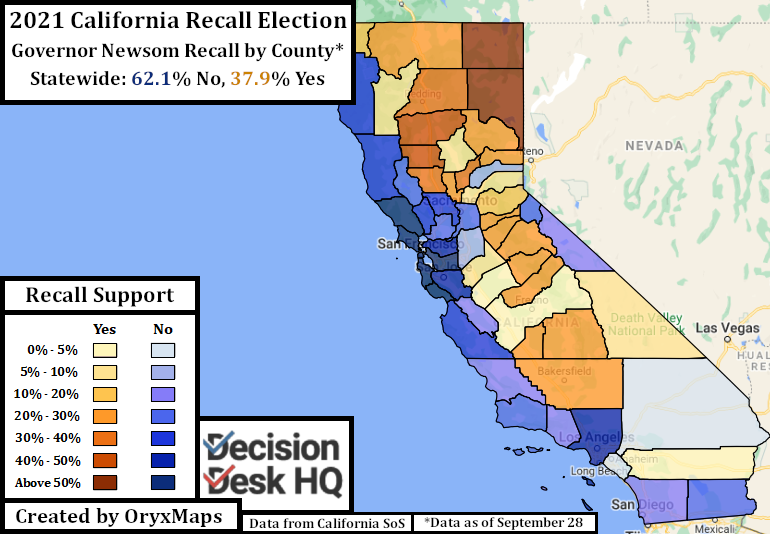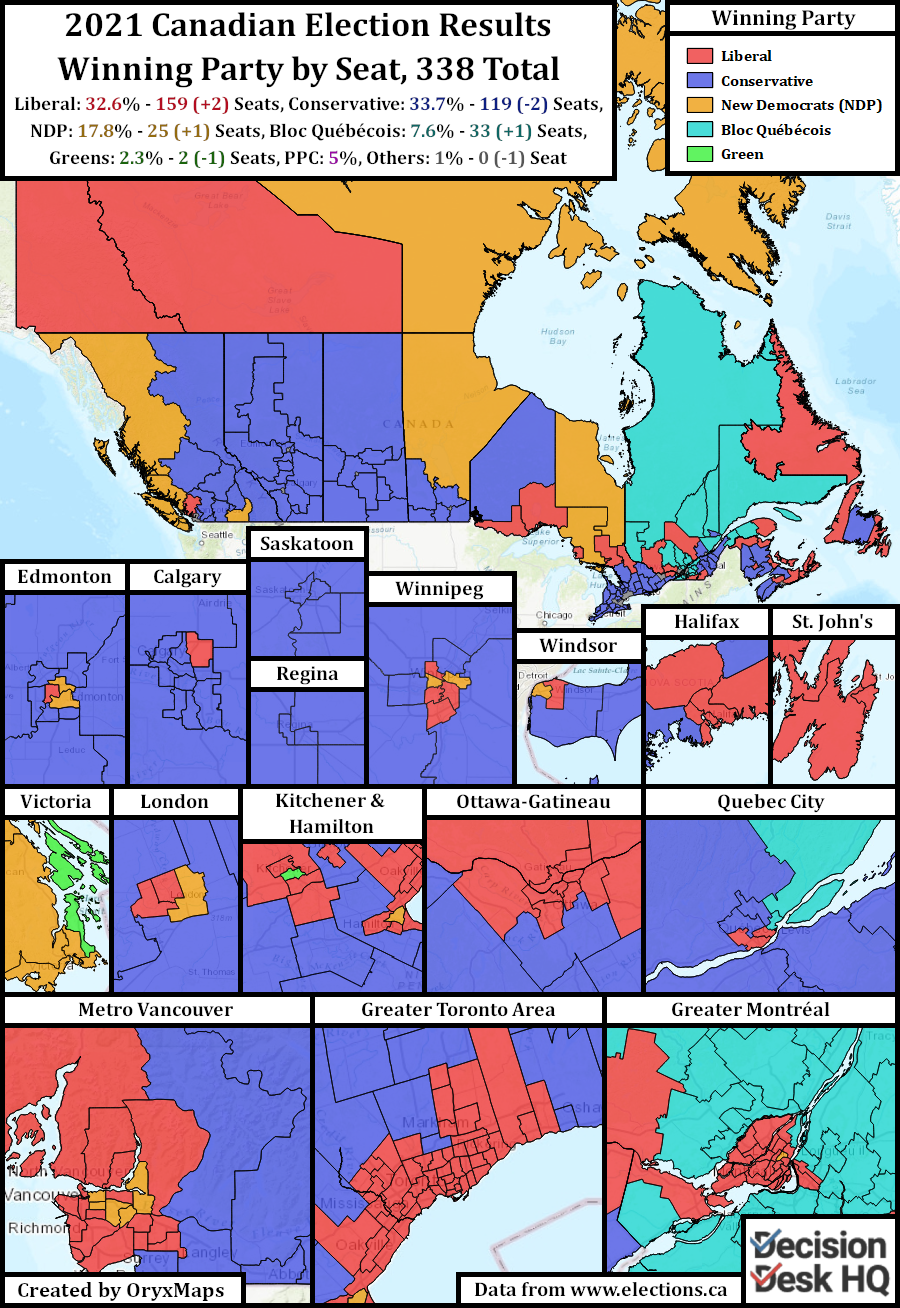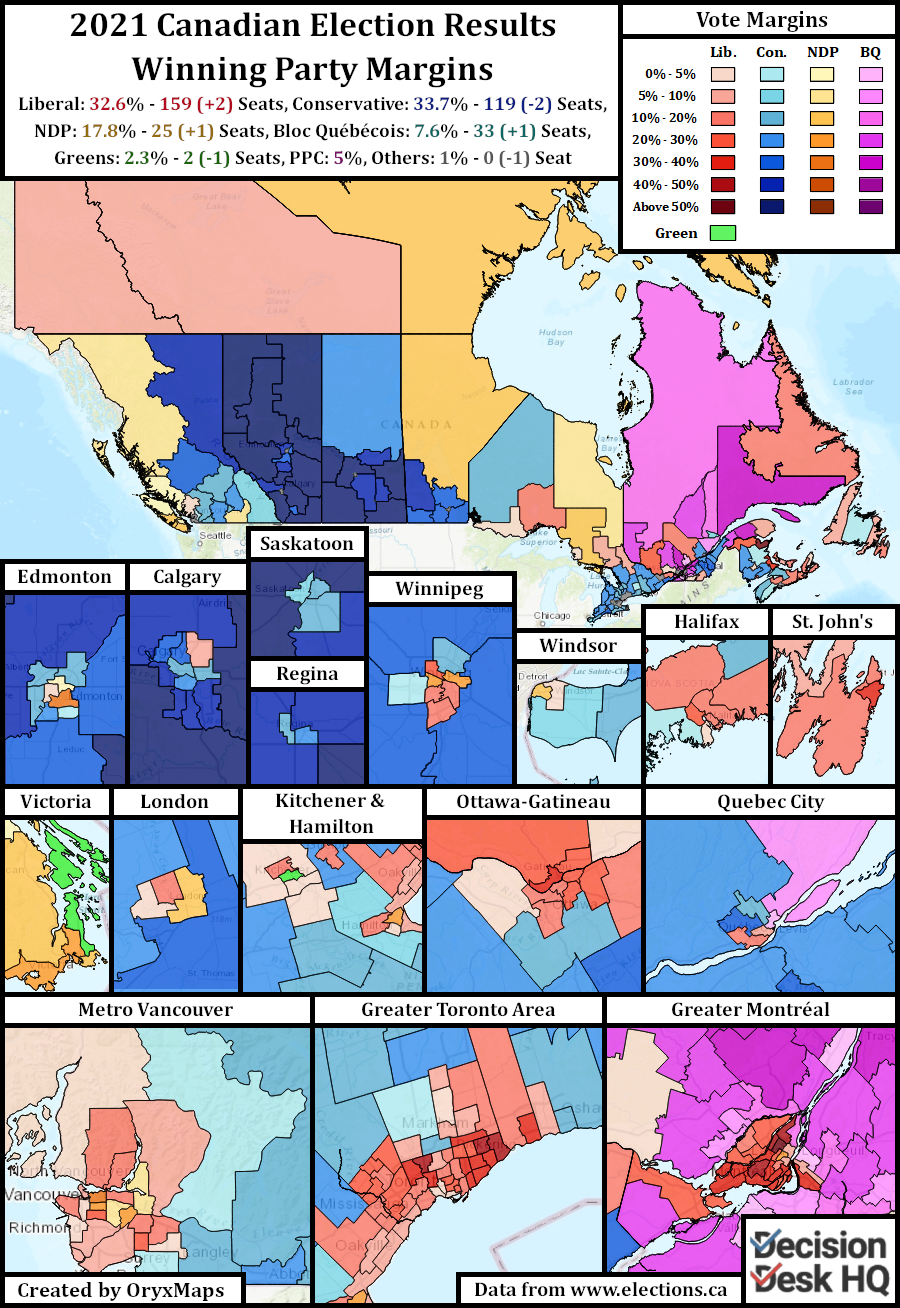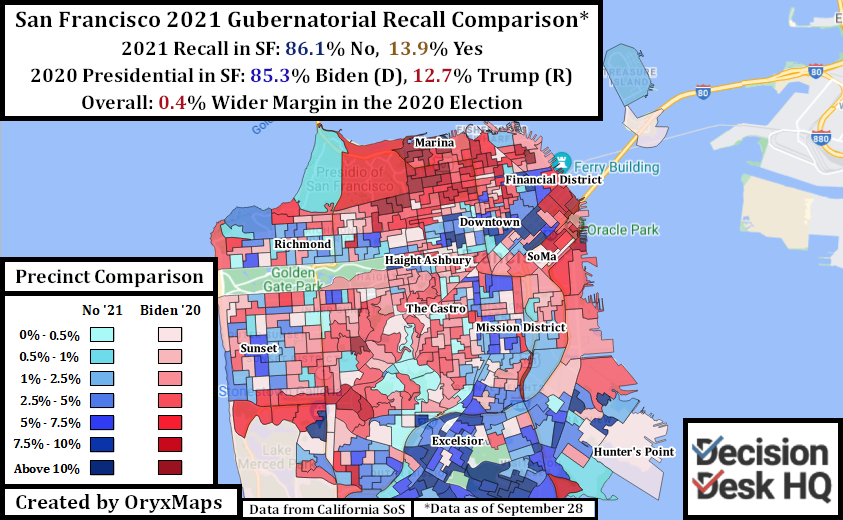On September 14th California voters rejected the recall petition against Democratic Governor Gavin Newsom. On September 20th Canadian voters rebuffed opposition challengers and re-elected Prime Minister Justin Trudeau’s Liberal Party. Despite the differing conditions and circumstances, both elections delivered results nearly identical to the most relevant, preceding election. California county Boards of Elections have yet to count the last few votes, but it appears that the final margin of retention versus rejection will be slightly larger than Newsom’s 2018 margin of victory, but slightly smaller than President Biden’s 2020 statewide result. Trudeau’s Liberals lost the popular vote by almost the same margin as in 2019 – and will only win two more seats out of 338 – when compared to their previous performance.
One campaign was significantly shorter, but both campaigns followed a similar trendline. A supermajority of both electorates did not want these elections. The incumbent started as the overwhelming favorite, a series of missteps tightened the race, then marginal voters recognized the election could be close and rallied to defend the incumbent. Both elections were condemned as wastes of the government’s time and money after the electoral repetition became clear.
The crucial difference between the California and Canada elections is popular expectations. Republicans organized the California recall to remove Democratic Governor Newsom, whereas Trudeau and the Liberals called the ‘Snap’ Canadian election to improve their position in Parliament. The recall election strengthened Newsom and punished the California GOP, the Canadian election weakened the victorious Liberals because they failed to achieve their electoral objectives.
Similar Campaigns
The recall campaign against Governor Gavin Newsom unofficially began in November 2020 even though the petition started circulating earlier. The petition gathered momentum after the French Laundry restaurant incident, in which Governor Newsom violated his rules against mass gatherings. This began seven months of unofficial campaigning before the recall petition qualified for the ballot, followed by a two-and-a-half month official election period. In Canada, observers knew that Trudeau’s Liberals desired a snap election for half a year, but the declaration only became obvious in early August. Only 36 days separated Canada’s official start of the campaign and election day.
Despite these differences, both incumbent’s official campaigns began as favorites. Newsom had just reopened California and state vaccination rates were high. Trudeau effectively managed Canada’s pandemic policies and the Canadian population became among the most vaccinated in the world. Both leaders had comparatively high approval ratings, and both entered the official campaign with comparatively high polling positions. Newsom enjoyed the 20-point margins typical of statewide California Democrats and Trudeau’s Liberals had five-to-ten-point leads unusual for national parties in a first-past-the-post environment.
Both candidates immediately suffered setbacks from new waves of Coronavirus infections. California State and county governments reimplemented precautionary pandemic measures in response to rising Delta Variant cases. These measures animated Republican voters, previously estranged from the recall process. In Canada, Prime Minister Trudeau was unable to explain why he called an election with Canada facing its own fourth Coronavirus wave. This birthed a narrative that the election was unnecessary and potentially dangerous, with no purpose but to increase Liberal power. Conservative voters put aside their infighting and united in opposition to Trudeau’s ambition.
Both elections tightened. Summer polling for California’s recall election revealed a single-digit margin lead for retaining the Governor. Canadian polls tightened after only one week of campaigning. Trudeau failed to produce a platform, took fire for not having a Canadian exit plan from Afghanistan, faced campaign protests from anti-vaccine activists, and drew criticism for calling the unpopular election. Then Canadian polls flipped as the Conservatives began to build leads off Conservative leader Erin O’Toole’s approachable proposals.
These polling reversals were not achieved by convincing swing voters to abandon their previous preferences. California polls found a sizable enthusiasm gap between Republicans, who were near-universally eager to vote, and more apathetic Democrats. California Republicans could win the election if enough of the dominant Democrats did not see the need to vote. The Canadian electorate meanwhile viewed the election as likely to return a Liberal Government; surely Trudeau would not call an election he could lose. Voters saw no point in participating in this disagreeable election although polls of voters who were energized to participate now favored the Conservatives.

The mid-campaign polling collapse helped both Trudeau and Newsom because both ran against the hypothetical outcome suggested by these early polls. The lack of a California Democratic alternative candidate meant that a successful recall would install a Republican Governor. Democrats promoted these poll results to make their base voters aware of the race and what failing to vote would entail. Newsom ran against Larry Elder, the most popular of the GOP candidates. Fear, urgency, and Larry Elder’s controversial positions convinced California’s Democratic electorate that they were needed to defend their governor. Polls returned to 20-point margins in favor of retaining Governor Newsom, eventually replicating the Democrat’s 2018 Gubernatorial landslide.
Trudeau similarly reversed his sagging polls by changing the narrative. The Liberal campaign went after base voters who previously did not express interest in voting and progressive voters who thought of defecting from the Liberals to the New Democratic Party. Trudeau used the Canadian debates to break the idea of guaranteed Liberal government while also highlighting parts of the Conservative platform disliked by the wider electorate. Trudeau persuaded marginal voters to support the Liberal Party by telling them that the race was close and that a Conservative government would be dangerous.

The polls narrowed to the 2019 topline result, a topline favorable for the Liberals because of the efficient distribution of Liberal voters. Again in 2021, more overall voters preferred the Conservatives, but the concentration of Conservative voters in safe seats allowed the Liberals to sweep marginal suburbs. The 2021 result matched the 2019 result.
Different Outcomes, Similar Trends
Democrats framed the California Recall election as an attack on voters’ prior intentions. The only way to defend voters’ past desires was to defend Governor Newsom. In Canada, Trudeau’s Liberals had to defend their decision to call a snap election, perceived as unnecessary by voters. The Liberals were unable to produce compelling reasons for voters to give them a majority – the desired outcome – but they had numerous reasons to justify a continued Liberal minority. These two narratives – one in California and one in Canada – produced similar electoral results but facilitated different political outcomes.
More voters participated in the California recall election than the 2018 Gubernatorial election – the most comparable off-cycle contest. In Canada, turnout was worse this year than the preceding two contests. It was the fifth worst federal turnout in the past 100 years. California voters took the recall as a challenge, while Canadians lacked compelling reasons for participation. This divergence occurred even though both election agencies made it easier to vote than ever previously. California mailed a ballot to all registered voters; Canada expanded mail and early voting in response to the pandemic.
Governor Newsom emerges from the recall with a renewed political mandate. The election produced no data to confirm voters who flipped Democrat during the Trump presidency will return to the Republican party. The state GOP exhausted its war chest and their top statewide candidates – John Cox and Kevin Faulconer – trailed novice Larry Elder. New political capital from the recall’s failure allowed Newsom to pass landmark and controversial housing reform the day after the recall. Democrats immediately began the process of reforming and limiting future recalls.

Blame for the Canadian Election falls equally on all parties. Trudeau shoulders the most; he called an unpopular election, gambled for more seats, and at times appeared to have lost everything. An electoral stalemate means Trudeau weakened his own political value while achieving few of his goals. The opposition parties however have their own electoral conundrums. Despite the unpopularity of the contest and the large swings in their favor halfway through the campaign, all opposition parties failed to achieve any, durable goal. The Conservatives, the NDP, the Canadian Greens, and even perhaps the Bloc Québécois failed to seize the initiative and demonstrate themselves as viable alternatives (where relevant) to Trudeau’s Liberals. Post-election polls already find strong voter support for removing their party’s leader – with majorities supporting the ouster of Trudeau, Conservative leader Erin O’Toole, and Green Party leader Annamie Paul who resigned on Monday.

The coalitions built to achieve these divergent outcomes in California and Canada are strikingly similar. Both Trudeau and Newsom lost support in rural and small-town areas when compared to previous elections. For Newsom, this was a combination of enormous differences in turnout between Hispanics and Whites – a long-term feature of southwestern off-cycle elections – along with drought and fire-related agitation among rural Republicans. For Trudeau, this was partially a gradual decline in favor of the Conservatives, leading to a handful of seat losses, and partially a product of the Populist anti-vaccination People’s Party growing from 1.6% to 5%.

Despite California’s and Canada’s differing electorates and electoral systems, educated suburbanites protected both incumbents. Suburban voters’ support for the incumbents increased or remained at levels comparable to previous contests. This vote helped Newsom win suburban areas in Orange, Contra Costa, Santa Clara, Ventura, San Diego and other Counties by more than his margins in 2018. Trudeau rebuffed the Conservative advances in small towns with gains in suburban Vancouver and Toronto. The Vancouver gains are notable because the Liberals finished third in the province behind the NDP and the Conservatives, but gained enough seats to finish first in the seat count. The Liberal vote collapsed in certain NDP strongholds and the safe Conservative rural British Columbia seats, but it went up specifically in diverse suburban areas with marginal seats.

Both the Democrats in California and the Liberals in Canada uniquely surged in areas with large numbers of East Asian voters. This is visible in Orange County among once-Republican Koreans and Vietnamese, and the San Francisco Bay Area among Chinese and Japanese. This is also visible in the metro Vancouver suburb of Richmond among former Hong Kong and Taiwanese Chinese, the East Toronto Scarborough region, and its adjacent suburbs. Trudeau’s Liberals even won two Chinese-dominated seats they did not win in 2015 when they won a majority government. These elections join a small but growing set of election data from after the 2020 U.S. presidential election and among east Asian demographic subgroups with different political histories. It suggests that East Asians, a demographic with cultural pandemic experience from the 2002 SARS outbreak, are potentially trending away from parties that oppose precautionary coronavirus public safety measures.
Differing Expectations, Different Paths
All expectations for the California Gubernatorial recall depended upon the recall movement and its Republican backers proving themselves viable and ready to lead. If not, then there was no reason to treat the recall election as anything other than a waste of time. Newsom however was never in real danger of losing. Even when polls tightened the universe of untapped California Democratic voters remained large, and Democratic organizers simply needed to activate their electorate.
43% of voters trusted the partisan Democratic party line and rejected the premise of the recall by refusing to select a replacement candidate. This election proved once again that California is an overwhelmingly Democratic state. Rejection of the recall’s premises gives legitimacy to Democratic proposals to limit future recalls. These proposals would prevent agitators from triggering recalls anywhere statewide without the clear support of a majority of the electorate.
Trudeau now has to explain to Liberal supporters why the party failed to meet its own expectations. All Canadian parties must answer this question, but Trudeau more so because he called the snap election. The Liberals wanted a majority government and put their caucus through unnecessary risks for no real gain. Trudeau misjudged the electorate’s political appetite. He may not have ever been in a position to win the coveted majority government. Polls immediately began to tighten from the large pre-election Liberal leads and, from then on, the Liberals never enjoyed a polling lead larger than the poll’s margin of error.
Only 23 Parliamentary seats changed parties from 2019 to 2021. This is among the lowest in Canadian history. The main changes occurred below the topline, and did not help the Liberals. The Conservatives gained in crucial Atlantic and Ontario regions, and lost votes in the safe Prairies where they still have votes to spare. The NDP gained in dense Liberal cities. Both the Conservatives and the NDP are closer to the Liberal winner in more Liberal seats than in 2019. This election came close to being a net loss for the Liberals, but they held on and secured a draw.
Newsom emerges victorious, Trudeau emerges wounded with regrets. Voters in both contests preferred stability and incumbency, but they delivered different results in very similar elections.
Ben Lefkowitz (@OryxMaps) is a Contributor to Decision Desk HQ.